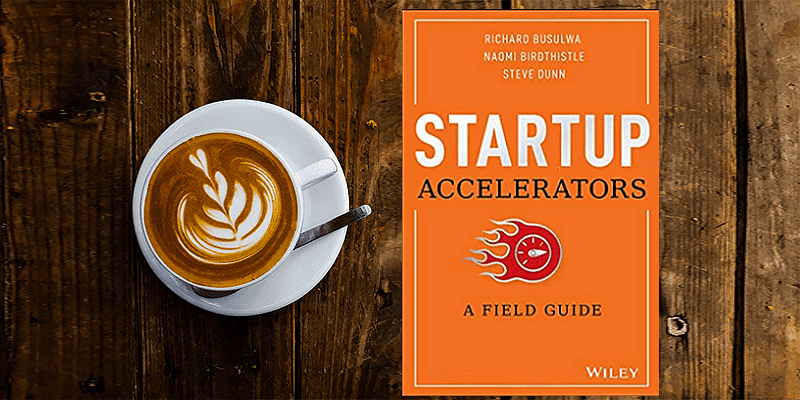Richard Busulwa, Naomi Birdthistle, and Steve Dunn are co-authors of the book Startup Accelerators: A Field Guide (see my book review here).
The book is packed with research analysis, first-hand interviews with founders and accelerator managers, and useful tables, comparing various accelerator offerings. The material is thoroughly referenced but also written in an accessible style for founders.
See also YourStory’s Book Review section with reviews of over 280 titles on creativity, entrepreneurship, innovation, social enterprise, and digital transformation.
Richard Busulwa is the author of Strategy Execution and Complexity and a researcher at Swinburne Institute of Technology. Naomi Birdthistle is an associate professor at Griffith University and also ran a consulting firm for 10 years. Steve Dunn is the CEO and Co-founder of IoT startup LEAPIN Digital Keys.
In this three-way chat with YourStory, the authors talk about the global outlook for accelerators, the impact of the coronavirus pandemic, and tips for aspiring founders.
See also YourStory’s Startup Hatch series of profiles of accelerators, incubators, makerspaces, co-working spaces, and entrepreneurship support organisations.
Edited excerpts from the interview:
YourStory [YS]: In the time since your book was published, what are some notable new accelerator models you have come across?
Richard Busulwa [RB]: From the literature we have been engaged with, accelerators have been more concerned with the push into virtual operations to effectively adapt to COVID-19. Although many accelerators already conducted virtual screening, most have obviously had to expand this to have most, if not all, accelerator programme activities occur virtually (for example, finalisation of accelerator agreements, programme manager meetings, curriculum presentations, mentor/advisor meetings, cohort team interactions, strategic partner and customer meetings, demo day, etc.).
While the push into virtual has had reported downsides such as reduced relationship intimacy, reduced founder accountability, reduced founder focus, and reduced ability of programme managers and mentors to observe startup status, we’ve also seen reported upsides.
For example, some founders have reported benefiting from removal of relocation and travel requirements, and other founders have reported greater accessibility of strategic partners and customers (for example, due to greater acceptability of virtual meetings). Some programme managers have reported on the ability to have bigger cohorts (for example, due to removal of co-working space limitations), and a number of programme managers are noting that some virtual demo days can have a much bigger audience than face to face ones.
We’re keen to see how the push into virtual operations impacts accelerator designs post-pandemic. That is, what aspects of virtual operations are kept and what aspects return to pre-pandemic ways of operating.
Besides the push into virtual operations, we’re seeing corporate accelerator and NFP/NGO/Impact accelerator models becoming more prevalent.
YS: How has the COVID-19 pandemic affected the accelerator movement? Are some accelerators shutting down, and have most pivoted to virtual mode?
Naomi Birdthistle [NB]: Unfortunately, I’ve seen lots of instances of co-working spaces shutting down due to COVID-19.
For many accelerators, the only way they have been able to survive the COVID-19 pandemic has been to shift to virtual operations. And, success with virtual operations has largely been influenced by accelerators’ effectiveness at communicating with stakeholders, and at facilitating sticky or intimate relationships in a virtual setting.
Interestingly, we are seeing some COVID-19 focused accelerators emerge. For example, Vrkush Ecosystem has put forward a COVID Accelerator for startups and innovators working to solve the challenges caused by this pandemic. This accelerator is a part of the World Economic Forum Global Shapers COVID Task Force.
It all depends on their communications strategy and their ability to be sticky with their participants and members of the accelerator.
YS: How was your book received? What were some of the responses and reactions you got?
RB: The book was launched just as the COVID-19 pandemic was starting; we hadn’t anticipated that this would be the case. So initially, it struggled to get the sort of press or attention we would have liked. But awareness of it has slowly been expanding through word of mouth.
The main audience so far has been accelerators using it in their accelerator programme welcome packs, academics using it in entrepreneurship courses (for example, in opportunity evaluation and entrepreneurial process focused topics), founders and prospective founders around the world, and entrepreneurial ecosystem policymakers.
We’ve been surprised by the international interest in the book — these have resulted in a lot of requests to translate it into different languages.

YS: What is your current field of research in entrepreneurship?
RB: My research focuses on founder well-being (that is, exploring the unique health risks associated with founder life, and how founders can best manage these risks to ensure health issues don’t end up sinking the startup), on entrepreneurial learning (how founders can maximise return on learning time), and on strategy for startups (what strategy means at different stages of startup evolution, and how to do it right).
NB: My current field of research in entrepreneurship focuses on disadvantaged groups that include youth entrepreneurship, migrant and refugee entrepreneurship, and women entrepreneurs. I am also interested in family businesses.
YS: How big a role do academics play in entrepreneurship? Can entrepreneurship really be formally taught?
NB: I believe entrepreneurship can be taught, and there is ample evidence that it can be - it’s just how it is best taught that is important.
As an entrepreneurship academic, I focus on the applied nature of entrepreneurship. I teach entrepreneurial behaviour, mindset, and the skills that an entrepreneur needs. We provide students with an opportunity to explore entrepreneurship and do it from an applied perspective.
For example, just recently, we discussed MVP, and after a 20-minute discussion, I got students to develop a Landing Page as an example of an MVP, and then we validated the MVP by testing it with the class.
As an academic, my role is to allow students to try it (that is, starting a business). They are provided with an environment that is comfortable for them to experience entrepreneurship, and to even fail and learn from that failure.
My role is also to research the area of entrepreneurship, and to bring the entrepreneur into the classroom so that students can learn from the entrepreneur but also the entrepreneur gets access to the leaders of the future.
YS: Most of the case studies in your book feature non-corporate accelerators. What are your findings with respect to corporate accelerators?
RB: Corporate accelerators and social impact accelerators provide established organisations with opportunities to engage startups to solve particular problems, to collaborate with startups on innovative projects, to identify potential startup acquisition targets, to drive a culture of entrepreneurship within the organisation, to get exposure to new ideas and practices, and to spot potential product/market disruption areas.
There are inhouse corporate accelerator models (for example, Wyra), hybrid corporate accelerators (for example, E.ON a:Agile), “powered by...” corporate accelerators (for example, Powered by Techstars), and consortium corporate accelerators (for example, Startup Autobahn).
There is growing interest in corporate accelerators as an accelerated innovation, change and transformation, and adaptability or agility vehicle for established organisations.
Startups can benefit from corporate and social impact accelerators in several ways (for example, having participating corporates as motivated first clients, having clear prospective acquirers of startups, having product co-creators, and having access to another source of funding).
But the challenge for startups may be ensuring that founders’ and corporate accelerator sponsor organisations’ interests remain aligned. The focus of our book was not on corporate or social impact accelerators; these would probably need a book addressing each one to address them in sufficient depth. We are starting to see some specific books on these types of accelerators.
YS: How should innovators strike that delicate balance between ‘Stick to your vision’ and ‘Adapt to a changed world’?
RB: This is a complex question, and I am not sure we’re the best to answer it. I can offer a view based on my strategy research. Based on that research, I would say entrepreneurs have to choose between executing fast enough to realise their vision before change makes it irrelevant, having a flexible enough vision that can be resilient to change, changing the vision to fit the times, and forgetting the vision thing altogether.
Either way, the latest strategy research suggests they ought to understand both deliberate and emergent strategy making. And, based on this understanding, they ought to adapt their leadership style and the leadership activities they perform so as to enable/facilitate both deliberate and emergent strategy making at their startup.

YS: Is there such a thing as the ‘ideal age’ for an entrepreneur, or can the startup bug strike you at any time? How should people keep themselves open to adopting an entrepreneurial career later in life?
Steve Dunn [SD]: To me, when it comes to actually classifying oneself as an ‘entrepreneur,’ I would say age is irrelevant. Many people will argue that age is just a number and should not affect your ability to become a successful entrepreneur — and that the startup bug can strike at any time.
A common meme I have often seen circulating has the title ‘Too young to start?’ and then has a timeline on it with Colonel Sanders, starting KFC at age 65; John Pemberton, starting Coca Cola at 65; and Jan Koum, starting WhatsApp at 35.
And of course, there are much younger founders like Mark Zuckerberg, starting Facebook at 19; or Cory Nieves, the 10-year-old founder of Mr Cory’s Cookies. If they can make it at these ages, then ‘hey you can too!’
But, in terms of achieving entrepreneurial milestones such as raising investment capital or successfully re-locating an early-stage startup to an entrepreneurial hotspot such as Silicon Valley, my experience suggests that age can be important. I believe some VC’s and angels may be more attracted to young, coachable entrepreneurs rather than someone older than them or people approaching retirement age.
YS: It’s one thing to fail with a product, and a bigger dimension to fail with a company. How should founders regroup in these two situations?
SD: Based on the experiences I have had, my current view is that being a startup founder is about going on a journey of discovery. On the journey, you will learn many new things; you will try out many things; you will meet many people; you will have many new amazing experiences.
Founders should keep reminding themselves that they are on this journey of discovery, and they should look back on that journey often to see how far they have come.
If you fail, then look back and reflect on why you may have failed. Try to connect the dots, look for the patterns, and realise the ‘why.’ Also, take some time to have a good look inside yourself to see if the ‘fire is still there in the belly.’ Are you still motivated by your industry, your market, your product?
If the answer is yes and you’ve worked out why then you just dust yourself off and continue on the journey.
RB: Based on the experiences I have had, the motivation and opportunity to regroup is shaped by how founders see these events. If they see them as “failures,” then regrouping and pursuing the next opportunity can be a challenge.
If they see them as the results of experiments, I think it is easier to sidestep self-blame, to learn from what happened, and to look for or pursue the next opportunity.
It took me two years and a depressive episode to get over my first startup not working out. I had never entertained the possibility that it wouldn’t work out. And, my planning and execution didn’t take into account the possibility of things working out differently to how I saw them working out.
When things didn’t work out that way, I saw it as a major failure and beat myself up for two years after the experience. Based on that experience, I really believe seeing it as failure is detrimental. So is acting as if failure isn’t a likely possibility.
I think founders can benefit a lot from understanding how probable failure is, taking smart risks or fail-safe experiments, failing smartly, and maximising learning from failure.

YS: What are the Top Three success factors for government, academia, and industry to work together, and grow innovation and entrepreneurship in their countries?
NB: In every country, there is a range of institutions and entities performing startup support and advocacy activities (for example, startup accelerators, government commercialisation programmes, angel or venture capital investors, tertiary institutions).
The types of institutions that come together, the unique roles they play, and their collective effectiveness at supporting startup success have been shown to have a significant impact on economic development and prosperity. To me, the top three success factors in getting these different institutions to effectively work together to maximise innovation and entrepreneurship are:
● Get together in the same room and talk (for example, work out who does what, which challenges each support entity faces, what gaps exist in startup support ecosystems, what opportunities exist to collaborate better).
● Have government seed funding available for industry to engage academia to do some research. This leads to engagement occurring between industry and academia and meaningful research being conducted.
● Have open and honest discussions about failure and the attitude to failure. And ensure you don’t penalise the entrepreneur whose business has failed. Instead, ensure that they are provided with a soft landing, and supports and opportunities to go forward in the future.
YS: Which are some of the successful accelerators in Australia? Are some of these accelerators expanding globally?
RB: Some of the most well-known accelerators in Australia include BlueChilli, Muru-D, Startmate, and Slingshot. BlueChilli has had notable alumni such as Folktale, Benchon, and SafetyCompas.
Muru-D has had notable alumni such as Caitre-d, Cuberider, Fluid Education, and Funetics. Startmate has had notable alumni such as Happy Inspector, Work180, Flirtey, and Everproof. And finally, Slingshot has had notable alumni such as Autoguru, CarNextDoor, Episoft, and Openagent.
Some of these startups serve global markets from Australia. And some, like Happy Inspector, have moved their operations abroad but still serve the Australian market.
YS: From your research in accelerators around the world, what are some pockets of specialised innovation you are seeing emerge in different countries?
NB: I am seeing lots of work within the AI space. I am also seeing lots of work happening in Allied Health, and how doctors and medical professionals are testing new ideas in accelerators - with endorsements from the hospital. So, lots of intrapreneurial activities happening.
YS: What is your next book going to be about?
RB: We are still discussing what startup evolution issue to address next that is at the intersection of our different research and practice interests.
For example, Steve is more interested in fundraising issues. Naomi is more interested in female entrepreneurship, minority entrepreneurship (for example, youth entrepreneurship, migrant, and refugee entrepreneurship), and family entrepreneurship issues.
And, I am more interested in founder wellbeing, strategy for startups, and entrepreneurial learning. I’m sure we’ll settle on another important issue or topic soon that aligns with our different interests.
YS: What are your parting message to the startups and aspiring entrepreneurs in our audience?
RB: There has never been a better time to be an aspiring entrepreneur. There is so much great “how to do it” content and so many entrepreneurship support institutions.
I think the challenge for entrepreneurs now is making the right choices about what content to consume, what learning activities to engage in, and what connections to build or learning communities to be a part of.
Making the right choices can dramatically improve entrepreneurs’ chances of doing the right things, in the right place, and at the right time – thus maximising their odds of startup success. I would recommend aspiring entrepreneurs start the learning process as early as possible.
And get involved as early as possible with entities like Startup School, Startup Weekend, and startup hackathons for early hands-on experience. Of course, once ready to found a startup, most entrepreneurs can really benefit from the right startup accelerators – although they have to be careful to select the right one (we outline how to do this in our book).
Edited by Suman Singh
Link : https://yourstory.com/2020/11/startup-accelerators-resilience
Author :- Madanmohan Rao ( )
December 01, 2020 at 07:20AM
YourStory







